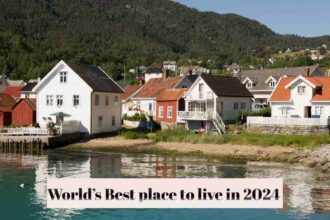SalamatRaho presents to you the story of Chewang Norphel- ‘the Ice Man of India also known as ‘The Glacier Man’.
Crisis gives birth to innovative ideas hence it is said necessity is indeed the mother of invention.
One of the most innovative inventions had to come from the son of the soil who could not see his people suffer – Chewang Norphel.
Also Read: Sonam Wangchok: Selfless Son Of Ladakh – Nomad Lawyer
“Our globe is under new dramatic environmental pressure: our globe is warming, our ice caps melting, our glaciers receding, our coral is dying, our soils are eroding, our water tables falling, our fisheries are being depleted, our remaining rainforests shrinking. Something is very, very wrong with our ecosystem”- Richard Lamm
Impact Of Global Warming
From 1850’s onwards, most parts of the Earth’s surface have been affected by global warming which has led to tremendous destruction, especially for future generations.
Why Ladakh Is Vulnerable
Ladakh is one of the most sensitive and fragile regions of the Indian subcontinent, at an altitude of 3,000-3,500 metres above sea level, and has a low average annual rainfall rate of 50 mm.
Its arid climate makes conditions harsh for agriculture. Almost 90% of farmers in Ladakh are dependent for irrigation water on mountain glacier that melts through the spring and into the summer which is becoming scarce, resulting in severe shortage and drought situations. Many villages have become ghost villages because people left their farms due to the water crisis and no income.
Childhood Of Chewang Norphel
He was born in 1936 in Leh, which was a small village back then. He grew up in a farmer’s family with three brothers. They used to grow barley peas and potatoes. Belonging to a middle-class family, he went to the local school. As further studies were not possible there, Norphel went to Srinagar to study Science. He completed a diploma course in civil engineering from Lucknow in 1960. Immediately he joined the rural development department of Jammu and Kashmir in Ladakh as a civil engineer.
Background of Chewang Norphel
In 1997, Norphel joined the Leh Nutrition Project as a chief Project officer of this NGO, as project manager he worked mainly on watershed development.
He was in service for 35 years and retired in 1994. However, the government extended his service for 15 more months.
As a farmer’s child, he was always connected to the earth. While playing around in his field, Norphel noticed a public water supply main point which was near his house that has to be run 24hrs if it is not run continuously the water will freeze in pipes and leads to the bursting of pipes due to harsh winter. The little stream of water coming from the pipe flowed into the garden and formed a pool. During peak winters this puddle of water froze into an ice pool. Just 50ft below the garden, the main stream flowed where only a thin sheet of ice was formed as water kept flowing with high velocity.
He understood the reason for this phenomenon: the flowing water was moving too quickly to freeze, while the sluggish trickle of water beneath the trees was slow enough to freeze.
Winters are severe in Ladakh due to which there are no winter crops. It is not that Ladakh doesn’t have enough water. It has, but in the form of frozen ice.
The ice glaciers are frozen till June and then they melt and water flows away mostly to other neighbouring countries and goes wasted. But the sowing season is in April-May when there is no water for irrigation. This was the crux of the issue with no solution as all depended on nature’s course.
He found a simple solution to a complex problem. A technique to harvest winter waste water in the form of ice was discovered by Chewang Norphel.
Artificial Glaciers For Humanity
The idea that had lit a light bulb as a child, had remained in his mind. With this idea, in 1986, he created his first artificial glacier in Phuktsey village on a trial basis in 1986 with the cost of Rs. 90,000.
The advantage of this innovative idea is its simplicity and practicality. Around November, the water of nearby streams is diverted to the shaded area of a hill through appropriately designed distribution channels. Stone embankments are built at regular intervals, which control the water’s flow and thus its velocity, which helps it to freeze faster during peak winters in minus 30 degrees. Ice is formed, giving the frozen body of water the look of a glacier. This was how an artificial glacier was born in the arid desert of Ladakh.
Sir Norphel further explained that these artificial glaciers will increase the ground-water recharge, rejuvenating the spring and providing water for irrigation.
Often, multiple glaciers are created for one village at different altitudes. The glacier located closest to the village is at the lowest altitude and melts first, providing irrigation water during the sowing period in April-May. As the temperature rises, the next glacier at a higher altitude starts melting. The process of melting at different times continues to assure irrigation water to the agricultural fields below.
The farmers earlier were totally dependent on nature for irrigation. The glacier has made a big difference. They feel more confident about their food and financial security now, thanks to this new water irrigation system invented by Sir Chewang Norphel.
This process was not as easy as it sounds.
He gave this proposal for constructing artificial glaciers to many government organisations but back in those days, such ideas were considered crazy. Also, there was no such funds particularly for artificial glaciers. He got fed up trying to convince them, so gathered the villagers and initiated the first project in 1986. It was difficult convincing the farmers to join and help, but he gained support slowly and ground work started.
The Ice Man of India
Chewang Norphel collected funds and made the first project a success. It was a very difficult and slow process but he never lost hope and had full belief in his idea.
The success of his experiment continued and by 2012, 12 such artificial glaciers were created and then he went on to create many more such artificial glaciers across Ladakh, thereby earning his nickname — “The Ice Man of India”.
Largest glacier is the one at the Phuktsey village, which is 1.5 km length, 150 ft wide and about 2-4 ft in depth on average. It can supply water for the 4 hamlets that are Shara ,Shanyos , Phuktsey and Phuktsey Phu.
When people saw the result, they gained confidence in his idea and financial help started pouring in from several state-run programmes, the army and various national and international NGOs.
The biggest advantage he had was his idea was simple to replicate as the cost was not too high. It could be built with help of local skilled people and villagers. The cost of the latest new techniques used by other environmentalists are much higher compared to the traditional style Chewang used.
As more and more glaciers came up year by year, the landscape of Ladakh started changing. Farms were green in April and May and farmers grew more variety of crops now. Their revenue and standard of living increased. Many ghost villages once again saw life. Thousands of Ladakhi Villagers could re-establish their lives and not migrate to other regions. Thanks to Chewang Norphel.
News trickled out of Ladakh to other states and far frozen countries who started using his ideas.
Hard work won. Finally well-deserved awards started pouring in.
Awards And Accolades
- Best Rural Engineering Awards by the President of India in 1998.
- Far Eastern Economic Review by Gold Asian Innovation Award of Hong Kong 1999.
- Limca book of records 2006.
- Jamnalal Bajaj Foundation Award by President of India 2010.
- Real Hero Award by CNN-IBN, Reliance 2008.
- Then came the most prestigious award of all- The Padma Shri in 2015, the fourth highest Indian award, given by the President of India.
So far, he has received 16 awards.
A documentary movie was made on his discovery called The White Knight, which received many National and International Awards.
Many research students and pioneers came to study his project and took inspiration. Many have taken his ideas forward and also won awards themselves.
To accomplish great things, we must not only act, but also dream; not only plan, but also believe. And this is what Sir Chewang Norphel did. He believed in his idea..his dream…and saw that his dream became a reality.
Chewang Norphel is 86 now. His voice is soft and welcoming. It was one of my most humbling experiences listening to his stories and experiences.
When asked what he feels about global warming and change in the environment and Ladakh today.
he says
“While growing up, I remember how the river near my home used to overflow but as years went by, that river dried up during summers and that used to pain me. The mountains tops were covered with white snow 5 to 10 feet deep, now all I get to see are just white patches”
He recollects what Ladakh meant to him and he is happy that tourism has increased and bringing in revenue but yet, the advent of mass tourism has meant many things which has led to changes in food and dress habits, pollution has increased due to heavy transportation, ecologically beneficial mud houses have made way for concrete ones, Tourism has taken over as the new popular occupation instead of traditional age old farming, consumerism has diluted the local population’s natural environmental sensitivity and consciousness; and his birthplace, Leh, has turned into a bustling tourist destination.
He was constantly talking about how children in schools should be made aware of their culture, heritage and environment and youth should be more responsible about their legacy.
At 86, he jokes and says, “when I had the energy, I didn’t have the funds. Now I have the funds and recognition, but don’t have the energy”.
There was a lump in my throat hearing his shaky voice and I could feel the urge in him to go on and do more work for his land.
Like President Obama Says- ‘We are the first generation to feel the effect of climate change and the last generation who can do something about it.”
Team NomadLawyer salutes the contribution of Chewang Norphel.
We don’t value the contribution done by these true heroes, to save our planet. We should honour them with highest regard and pride. People like Sir Chewang Norphel are the real treasures of our country. Salute Sir!.
TELL YOUR STORY AT: [email protected]
What is SalamatRaho
Team NomadLawyer’s ambition is to positively impact the world through the stories of HumanKind. We believe in the art of storytelling. Through “Salamat Raho ”, we are creating a database for social good in the form of “Impact Stories”, which will help us achieve our goal and reach out to the world at large. By contributing through your stories and experience you create a significant impact on the community and an exceptional experience for yourself. Visit the NomadLawyer portal at nomadlawyer.org and you can also get in touch with us at [email protected]
We use hashtag #SalamatRaho for the seriesAlso Read: Volunteer Projects Archives – Nomad Lawyer



